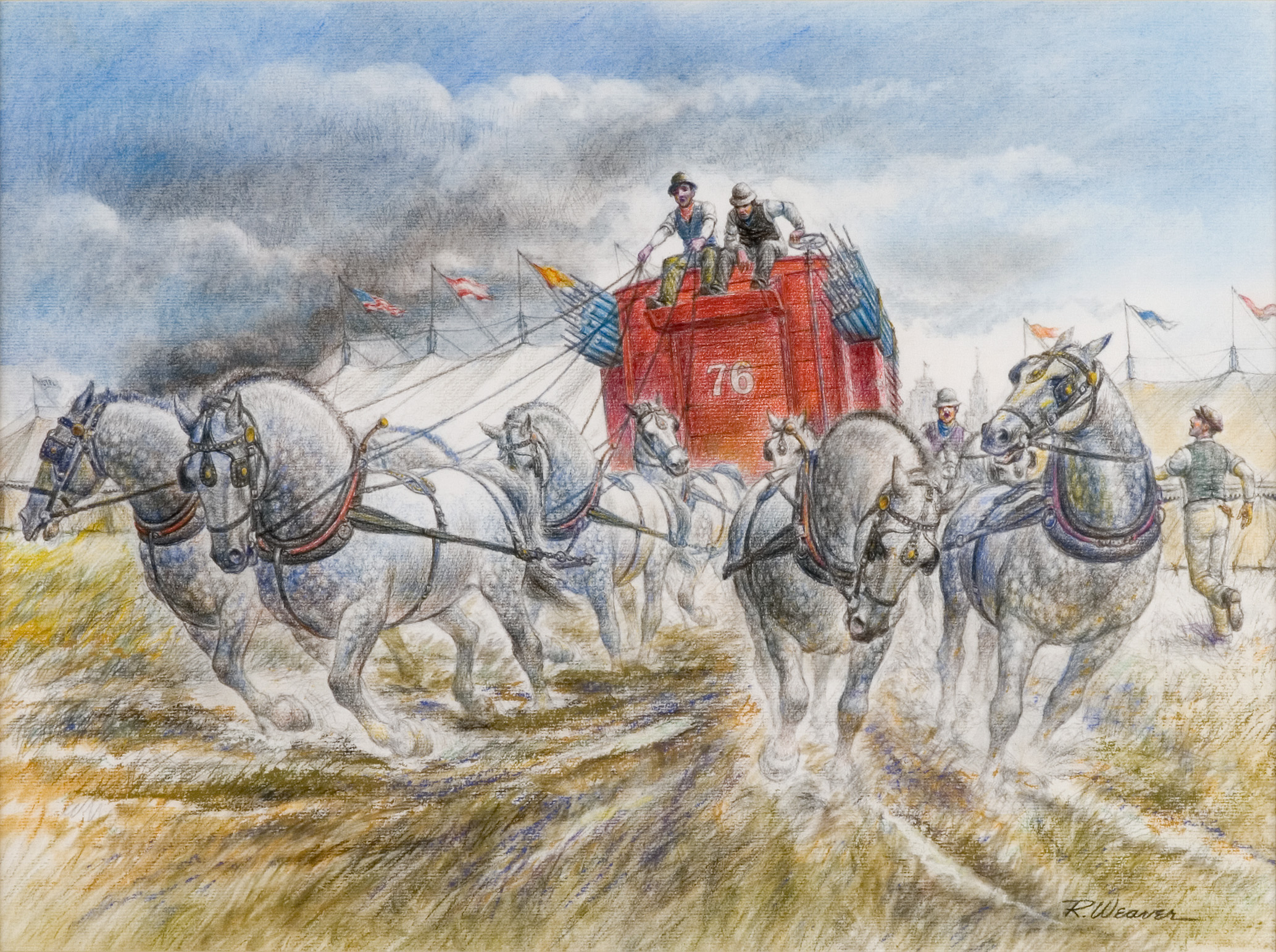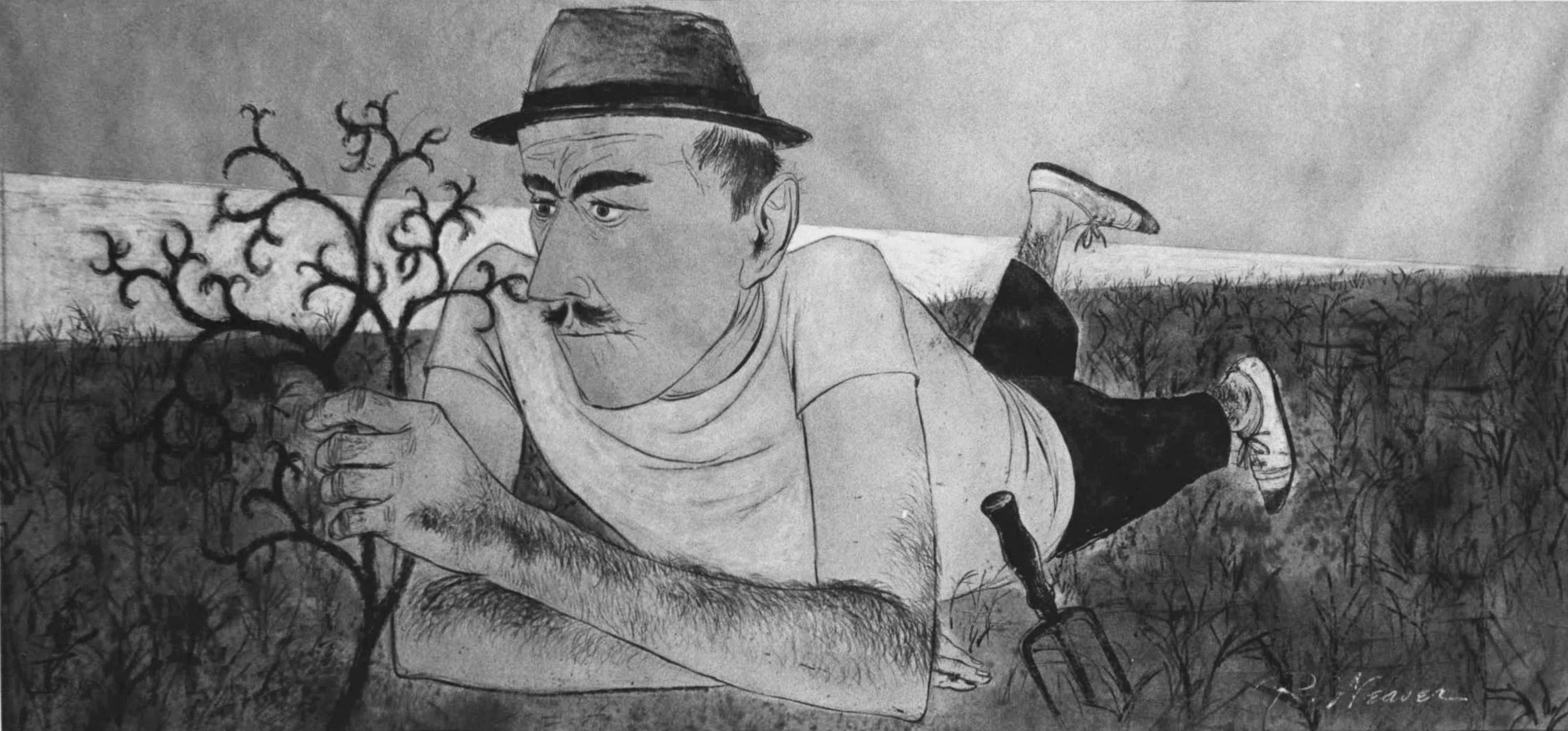
Graphite pencil, acrylic paint, and aluminum on gessoed panel. Signed R. Weaver lower right. This fantasy work based on the Biblical story of Jonah was featured in the 1974 Society of Illustrators, 16th Annual of American Illustration, Illustrators 16. Winner of the Mrs. Herman C. Krannert Merit Award at the 40th Indiana Artists Club Exhibition. This work now hangs in the Office of Admissions and Student Services at the Herron School of Art. (collection of the Herron School of Art, gift of the artist) #W197

Graphite pencil, pastels, and Prismacolor on illustration board. 32 x 17.5 inches. How many wrestlers do you see? #115

Charcoal pencil, with white chalk. 37.5 x 19 inches. #126

Graphite and water color on paper. 11 x 8.75 inches. Matted. Unsigned. REW would often take his students from John Herron Art Institute to sketch during rehearsals of the Butler University Ballet (Indianapolis, IN). This work, although a study, has great depth because of its composition observing reflections in the dance studio mirrors to set the principal dancers forward. #331A Estate stamped.

Prisma Color on illustration board.

Lithographic print, hand colored by the artist using Pismacolor, and pastels. REW hand colored only two of these Pole Wagon prints. One remains with the inventory the other is now in a private collection. The original drawing from which the prints were created was done in graphite pencil on gessoed panel. #180A

India ink and gouache on paper. Another gothic period work by REW in the same flavor as “Man With Scythe.” REW uses perspective to draw you into the subjects world of contemplation.

Grafite pencil, charcoal and chalk. Risley is a posture where the base person is lying supine, supporting one or more flyers with hands, feet and/or other parts of the body; spinning a person or object using only one's feet. The act is named after Richard Risley Carlisle (1814–1874) who developed this kind of act in the United States. (collection of the Peru Community Schools Art Gallery)

Graphite pencil, Prismacolor, on board. c. 1980.

Graphite pencil, india ink, gesso, on panel. In the artists words: “A play between light and heavy moods, using the juxtaposition of objects both classic and frivolous.”

Graphite pencil, and Prisma Color. This is just one in a series of twins. REW enjoyed observing people, and illustrating them in a whimsical manor.

REW produced several works using a torn paper layering technique, with water colors and/or Prismacolor. Harkening back to his 1956 painting "Circus Poster," now in the collection of the Indianapolis Museum of Art, REW was fascinated with the look of worn circus posters on buildings, reflections of the passing summers when the circus visited town. (private collection)

Pastel on illustration board. Exhibited at the 42nd Annual Exhibition of the Indiana Artists Club, October, 1974. "Blue Danube" by REW is a study in the human condition of circus life. Roustabouts were worked very hard on the traveling circus, so rest was wherever and whenever you could get it. The title of this work alludes to not just the color palette used in the composition, but to the music a tired roustabout (in this case with the Clyde Beatty – Cole Bros. Circus) is hearing from within the tent. In this case that of Johann Strauss, Jr. (collection of the International Circus Hall of Fame) #W18

Graphite pencil, and acrylic paint on gesso panel. Winner of the Mrs. Donald Mattison Merit Award at the 1971 Indiana Artists Club Exhibition. Like many during the late 1960's into 1970's REW was influenced by the the technological blossoming of the space age, and magazines such as OMNI. His works took on a much more symmetrical and techno style developing into what he referred to as "Circus Immaculate." "My Sister Nio" is just such a work. The Nio Nito Sisters did an amazing wire act at that time. So convincing and flawless was their performance that REW imagined that they must have gyroscopes in their heads, hence his fantastic illustration of the duo.

Pastel and Prisma color on board. This work was featured first in the exhibition “Two Centuries of CIRCUS ART - Center Ring: The Artist” at the Milwaukee Art Museum, May 7 - June 28, 1981. The exhibit of art on circus themes that included works by Picasso, Matisse, Chagall and Calder, as well as contemporary Wisconsin and American artists including REW, plus a healthy swath of posters, banners and circus memorabilia. The exhibition toured to Columbus, Ohio; Albany, N.Y.; and Washington, DC. It was first shown at the artist’s solo exhibition Indiana State Museum from September 25, 1977 through January 15, 1978. Because of the exhibition's tremendous reception, and attendance, it was held over at the ISM until February 15, 1978. (collection of The Indiana State Museum)

Graphite and colored pencil on paper. 14” x 11,” signed R. Weaver lower right. A color study sketch for one of REW’s last painting prior to the artist’s passing. #210 (private collection)

Graphite and colored pencil on paper. 14” x 11”, signed R. Weaver lower right. Another late color sketch by the artist of a classic performance sketch by the great clown Emmitt Kelly. Kelly would work in concert with the spotlight technician to create the elusion of a diminishing spotlight as he swept. #208 (private collection)

















Graphite pencil, acrylic paint, and aluminum on gessoed panel. Signed R. Weaver lower right. This fantasy work based on the Biblical story of Jonah was featured in the 1974 Society of Illustrators, 16th Annual of American Illustration, Illustrators 16. Winner of the Mrs. Herman C. Krannert Merit Award at the 40th Indiana Artists Club Exhibition. This work now hangs in the Office of Admissions and Student Services at the Herron School of Art. (collection of the Herron School of Art, gift of the artist) #W197
Graphite pencil, pastels, and Prismacolor on illustration board. 32 x 17.5 inches. How many wrestlers do you see? #115
Charcoal pencil, with white chalk. 37.5 x 19 inches. #126
Graphite and water color on paper. 11 x 8.75 inches. Matted. Unsigned. REW would often take his students from John Herron Art Institute to sketch during rehearsals of the Butler University Ballet (Indianapolis, IN). This work, although a study, has great depth because of its composition observing reflections in the dance studio mirrors to set the principal dancers forward. #331A Estate stamped.
Prisma Color on illustration board.
Lithographic print, hand colored by the artist using Pismacolor, and pastels. REW hand colored only two of these Pole Wagon prints. One remains with the inventory the other is now in a private collection. The original drawing from which the prints were created was done in graphite pencil on gessoed panel. #180A
India ink and gouache on paper. Another gothic period work by REW in the same flavor as “Man With Scythe.” REW uses perspective to draw you into the subjects world of contemplation.
Grafite pencil, charcoal and chalk. Risley is a posture where the base person is lying supine, supporting one or more flyers with hands, feet and/or other parts of the body; spinning a person or object using only one's feet. The act is named after Richard Risley Carlisle (1814–1874) who developed this kind of act in the United States. (collection of the Peru Community Schools Art Gallery)
Graphite pencil, Prismacolor, on board. c. 1980.
Graphite pencil, india ink, gesso, on panel. In the artists words: “A play between light and heavy moods, using the juxtaposition of objects both classic and frivolous.”
Graphite pencil, and Prisma Color. This is just one in a series of twins. REW enjoyed observing people, and illustrating them in a whimsical manor.
REW produced several works using a torn paper layering technique, with water colors and/or Prismacolor. Harkening back to his 1956 painting "Circus Poster," now in the collection of the Indianapolis Museum of Art, REW was fascinated with the look of worn circus posters on buildings, reflections of the passing summers when the circus visited town. (private collection)
Pastel on illustration board. Exhibited at the 42nd Annual Exhibition of the Indiana Artists Club, October, 1974. "Blue Danube" by REW is a study in the human condition of circus life. Roustabouts were worked very hard on the traveling circus, so rest was wherever and whenever you could get it. The title of this work alludes to not just the color palette used in the composition, but to the music a tired roustabout (in this case with the Clyde Beatty – Cole Bros. Circus) is hearing from within the tent. In this case that of Johann Strauss, Jr. (collection of the International Circus Hall of Fame) #W18
Graphite pencil, and acrylic paint on gesso panel. Winner of the Mrs. Donald Mattison Merit Award at the 1971 Indiana Artists Club Exhibition. Like many during the late 1960's into 1970's REW was influenced by the the technological blossoming of the space age, and magazines such as OMNI. His works took on a much more symmetrical and techno style developing into what he referred to as "Circus Immaculate." "My Sister Nio" is just such a work. The Nio Nito Sisters did an amazing wire act at that time. So convincing and flawless was their performance that REW imagined that they must have gyroscopes in their heads, hence his fantastic illustration of the duo.
Pastel and Prisma color on board. This work was featured first in the exhibition “Two Centuries of CIRCUS ART - Center Ring: The Artist” at the Milwaukee Art Museum, May 7 - June 28, 1981. The exhibit of art on circus themes that included works by Picasso, Matisse, Chagall and Calder, as well as contemporary Wisconsin and American artists including REW, plus a healthy swath of posters, banners and circus memorabilia. The exhibition toured to Columbus, Ohio; Albany, N.Y.; and Washington, DC. It was first shown at the artist’s solo exhibition Indiana State Museum from September 25, 1977 through January 15, 1978. Because of the exhibition's tremendous reception, and attendance, it was held over at the ISM until February 15, 1978. (collection of The Indiana State Museum)
Graphite and colored pencil on paper. 14” x 11,” signed R. Weaver lower right. A color study sketch for one of REW’s last painting prior to the artist’s passing. #210 (private collection)
Graphite and colored pencil on paper. 14” x 11”, signed R. Weaver lower right. Another late color sketch by the artist of a classic performance sketch by the great clown Emmitt Kelly. Kelly would work in concert with the spotlight technician to create the elusion of a diminishing spotlight as he swept. #208 (private collection)